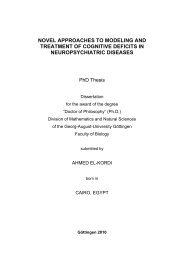Cortical and subcortical mechanisms in persistent stuttering ...
Cortical and subcortical mechanisms in persistent stuttering ...
Cortical and subcortical mechanisms in persistent stuttering ...
Create successful ePaper yourself
Turn your PDF publications into a flip-book with our unique Google optimized e-Paper software.
Content<br />
Abbreviations .......................................................................................................................... 7<br />
1 Introduction ............................................................................................................................ 9<br />
1.1 Components of the process of fluent articulation ...................................................... 10<br />
1.2 What is stutter<strong>in</strong>g? ..................................................................................................... 12<br />
1.3 Subtypes of stutter<strong>in</strong>g ................................................................................................ 13<br />
1.3.1 Acquired stutter<strong>in</strong>g ....................................................................................................... 13<br />
1.3.2 Psychogenic stutter<strong>in</strong>g .................................................................................................. 13<br />
1.3.3 Persistent stutter<strong>in</strong>g ...................................................................................................... 13<br />
1.4 Approaches to expla<strong>in</strong> stutter<strong>in</strong>g ............................................................................... 15<br />
1.4.1 Psychol<strong>in</strong>guistic approach ............................................................................................ 15<br />
1.4.2 Motor deficit perspective .............................................................................................. 16<br />
1.5 Neurophysiological approaches to expla<strong>in</strong> stutter<strong>in</strong>g ................................................ 17<br />
1.5.1 The cerebral dom<strong>in</strong>ance hypothesis ............................................................................. 18<br />
1.5.2 The basal ganglia hypothesis ........................................................................................ 21<br />
1.5.3 The disconnection hypothesis ....................................................................................... 24<br />
1.6 Scope of the dissertation ............................................................................................ 27<br />
2 Orig<strong>in</strong>al Articles ................................................................................................................... 29<br />
2.1 Right-shift for non-speech motor process<strong>in</strong>g <strong>in</strong> adults who stutter ................................ 31<br />
2.2 Reduced <strong>in</strong>tracortical <strong>in</strong>hibition <strong>and</strong> facilitation <strong>in</strong> the primary motor tongue<br />
representation of adults who stutter ...................................................................................... 61<br />
2.3 Instable phoneme categorization <strong>in</strong> adults who stutter ................................................... 95<br />
3 Summary ............................................................................................................................ 123<br />
4 Conclusions <strong>and</strong> Future Prospects ...................................................................................... 125<br />
4.1 The TMS approach ....................................................................................................... 125<br />
4.2 The speech perception approach ................................................................................... 126<br />
4.3 Future directions ........................................................................................................... 129<br />
Appendix A – Levelt’s psychol<strong>in</strong>guistic model <strong>and</strong> the DIVA model .................................. 131<br />
5



